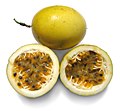Passion fruit (fruit)

The passion fruit (Portuguese: maracujá and Spanish: maracuyá, both from the Tupi mara kuya "fruit that serves itself" or "food in a cuia") is the fruit of a number of plants in the genus Passiflora.[1][2]
Description[edit]
Passion fruits are round or oval, and range from a width of 1.5 to 3 inches (3.81 to 7.62 centimeters).[1] They can be yellow, red, purple, and green.[1]
History[edit]
The passion fruit was first introduced to Europe in 1553.[3]
Etymology[edit]
Maracujá[edit]
The Portuguese maracujá and Spanish maracuyá are both derived from the Tupi mara kuya "fruit that serves itself" or "food in a cuia".
Passion fruit[edit]
The term 'passion fruit' in English comes from the passion flower, as an English translation of the Latin genus name, Passiflora, and may be spelled "passion fruit", "passionfruit", or "passion-fruit".[1][4] Around 1700, the name Passiflora was given by missionaries in Brazil as an educational aid to convert the indigenous inhabitants to Christianity: its name was flor das cinco chagas or "flower of the five wounds" to illustrate the crucifixion of Christ and his resurrection,[5] with other plant components also named after an emblem in the Passion of Jesus.[4]
Varieties[edit]

Well known edible passion fruits can be divided into four main types:
- purple passion fruit (fruits of Passiflora edulis Sims),
- yellow passion fruit (Passiflora edulis f. flavicarpa Deg.),
- sweet granadilla (Passiflora ligularis),
- giant granadilla (Passiflora quadrangularis L.).[6]
Uses[edit]
The fruits have a juicy edible center composed of a large number of seeds.[1] The part of the fruit that is used (eaten) is the pulpy juicy seeds. Passion fruits can also be squeezed to make juice.[1] It is also used in pastries and other baked products.
Composition[edit]
Nutrition[edit]
| Nutritional value per 100 g (3.5 oz) | |
|---|---|
| Energy | 406 kJ (97 kcal) |
23.4 g | |
| Sugars | 11.2 g |
| Dietary fiber | 10.4 g |
0.7 g | |
2.2 g | |
| Vitamins | Quantity %DV† |
| Vitamin A equiv. | 7% 64 μg7% 743 μg |
| Riboflavin (B2) | 10% 0.13 mg |
| Niacin (B3) | 9% 1.5 mg |
| Vitamin B6 | 6% 0.1 mg |
| Folate (B9) | 4% 14 μg |
| Choline | 1% 7.6 mg |
| Vitamin C | 33% 30 mg |
| Vitamin K | 1% 0.7 μg |
| Minerals | Quantity %DV† |
| Calcium | 1% 12 mg |
| Iron | 9% 1.6 mg |
| Magnesium | 7% 29 mg |
| Phosphorus | 5% 68 mg |
| Potassium | 12% 348 mg |
| Sodium | 1% 28 mg |
| Zinc | 1% 0.1 mg |
| Other constituents | Quantity |
| Water | 72.9 g |
| †Percentages estimated using US recommendations for adults,[7] except for potassium, which is estimated based on expert recommendation from the National Academies.[8] | |
Raw passion fruit is 73% water, 23% carbohydrates, 2% protein, and 1% fat (table). In a 100 gram reference amount, raw passion fruit supplies 97 calories, and is a rich source of vitamin C (36% of the Daily Value, DV) and a moderate source of riboflavin (11% DV), niacin (10% DV), iron (12% DV), and phosphorus (10% DV) (table). No other micronutrients are in significant content.
Phytochemicals[edit]
Several varieties of passion fruit are rich in polyphenols,[9][10] and some contain prunasin and other cyanogenic glycosides in the peel and juice.[11]
Gallery[edit]
-
Purple passion fruit (Passiflora edulis)
-
Yellow passion fruit (Passiflora edulis f. flavicarpa)
-
Passiflora ligularis fruit
-
Red, yellow, and green Passiflora edulis
-
Giant granadilla (Passiflora quadrangularis L.)
-
Unripe common passion fruit
See also[edit]
References[edit]
- ^ a b c d e f Morton JF (1987). "Passionfruit, p. 320–328; In: Fruits of Warm Climates". NewCrop, Center for New Crops and Plant Products, Department of Horticulture and Landscape Architecture at Purdue University, W. Lafayette, Indiana. Retrieved 22 January 2020.
- ^ Dennis S. Hill (16 July 2008). Pests of Crops in Warmer Climates and Their Control. Springer Science & Business Media. pp. 605–. ISBN 978-1-4020-6738-9.
- ^ "HS1406/HS1406: The Passion Fruit in Florida". edis.ifas.ufl.edu. Retrieved 2022-02-17.
- ^ a b Davidson, Alan (2014). Passion-fruit; In: The Oxford Companion to Food (page 597; Ed. 3). Oxford University Press, Oxford, UK. ISBN 978-0191040726.
- ^ "Origin of the Name Passionfruit".
- ^ Experts from Dole Food Company; Experts from The Mayo Clinic; Experts from UCLA Center for H (13 January 2002). Encyclopedia of Foods: A Guide to Healthy Nutrition. Elsevier. pp. 195–. ISBN 978-0-08-053087-1.
- ^ United States Food and Drug Administration (2024). "Daily Value on the Nutrition and Supplement Facts Labels". Retrieved 2024-03-28.
- ^ National Academies of Sciences, Engineering, and Medicine; Health and Medicine Division; Food and Nutrition Board; Committee to Review the Dietary Reference Intakes for Sodium and Potassium (2019). Oria, Maria; Harrison, Meghan; Stallings, Virginia A. (eds.). Dietary Reference Intakes for Sodium and Potassium. The National Academies Collection: Reports funded by National Institutes of Health. Washington (DC): National Academies Press (US). ISBN 978-0-309-48834-1. PMID 30844154.
{{cite book}}: CS1 maint: multiple names: authors list (link) - ^ Talcott ST, Percival SS, Pittet-Moore J, Celoria C (2003). "Phytochemical composition and antioxidant stability of fortified yellow passion fruit (Passiflora edulis)". J Agric Food Chem. 51 (4): 935–41. doi:10.1021/jf020769q. PMID 12568552.
- ^ Devi Ramaiya S, Bujang JS, Zakaria MH, King WS, Shaffiq Sahrir MA (2013). "Sugars, ascorbic acid, total phenolic content and total antioxidant activity in passion fruit (Passiflora) cultivars". J Sci Food Agric. 93 (5): 1198–1205. doi:10.1002/jsfa.5876. PMID 23027609.
- ^ Chassagne D, Crouzet JC, Bayonove CL, Baumes RL (1996). "Identification and Quantification of Passion Fruit Cyanogenic Glycosides". J Agric Food Chem. 44 (12): 3817–3820. doi:10.1021/jf960381t.






